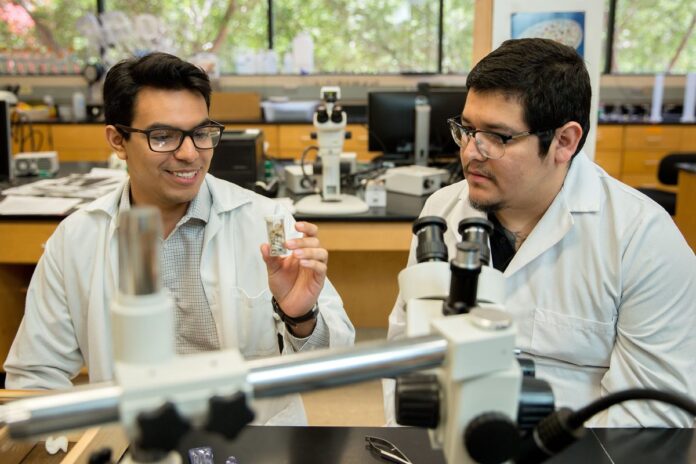BY Gail Fagan
Just when you think the 85,000 species of snails found worldwide are a lot, researchers at The University of Texas Rio Grande Valley go and add one more.
Dr. Kathryn E. Perez, assistant professor of biology, and her students, Eli Ruiz and Marco Martinez Cruz, have published a paper supporting identification of a new species of the South Texas scrub snail genus, Praticolella.
The new snail’s moniker? Praticolella salina, named for this small genus of salt-loving snail found only at South Padre Island and in coastal Cameron County.
“We kicked around some ideas, some different terms that represent the habitat and the appearance of the species, and decided we like salina the best; it refers to the very salty habitat this species likes,” Perez said.
Snail researchers have known of this type of snail for 100 years, but had always confused it with another species that is found in Mexico, Perez said. It was considered a distinct race of Praticolella griseola, which the UTRGV researchers demonstrated does not occur natively in Texas.
“It was having the DNA capabilities we have now, and the samples from enough different populations, that let us realize that this snail is distinct and deserved a unique name,” Perez said.
Ruiz, 25, a senior from McAllen majoring in biology, has spent nearly two years conducting fieldwork with Perez, helping to collect and study the morphology of more than 100 specimens gathered from six different sites in Cameron County.
“I mainly did a little bit of everything, but my focus was primarily on the anatomy of the snail,” said Ruiz, who measured and dissected the snails.
The morphology showed the P. salina species of snail had differences in color, bandings and aperture shape, which gave the researchers suspicions that it was a different species, he said.
“It was pretty exciting when we found out it was a new species. It was even more exciting when we were involved in naming the species,” said Ruiz, who recalled that the name coasta was also considered, reflecting the only place it can be found.
Ruiz, who first got interested in research when he heard about Perez’s evolutionary biology lab, said he enjoys the “unknown” aspect of research.
“Researchers are answering questions that don’t have answers yet, but you are the one answering them,” said Ruiz, who hopes to continue in research and earn a Ph.D. to teach or work for a government agency.
Working primarily on extraction and DNA sequencing was Cruz, 22, a graduate student in biology, who earned his bachelor’s degree in biology from UTRGV in 2016.
He said the first extractions had problems.
“The DNA that we wanted was not pure. We wanted it to be pure, without contaminations, so it took us a few months to figure out to get it exactly how we wanted it,” said Cruz, a native of Puebla, Mexico. “Research involves a lot of imagination, that’s kind of the main point of what we do here. What we try to do is, if you see some barriers in your technique or in your project that you don’t know how to get through, that’s when your imagination comes into play.”
Cruz hopes to earn a Ph.D. in biology and is interested in pursuing translational research, which applies findings from basic science to enhance human health and wellbeing.
He said it felt great to be involved in naming a new species.
“Not many people have the chance of naming something like this,” he said. “I had my chance.”
Perez, who earned her bachelor’s and master’s degrees from Angelo State University and a Ph.D. in biological sciences from the University of Alabama, said snails are an important part of the food web, eating plant material and fungus, and are a significant food source for birds and beetles.
“It was important to distinguish this snail as a distinct species,” she said. “This snail appears to require these very coastal areas in salt marsh habitats so you have to preserve that type of habitat for this snail to stick around. It has also been confused with an invasive species that can do damage to crops which agencies monitor and control. You don’t want to accidently kill your rare and native species.”
Perez plans to continue investigating other possibly distinct species of snails in South Texas.
The lab also will publish another paper soon on finding a population of apple snails in Brownsville.
Apple snails are large (two to six inches long), invasive freshwater snails from South America that have been found in Florida, and now in South Texas, that can do extensive damage to citrus, rice and sugarcane crops.
Perez hopes to set up a cadre of citizen scientists who will help locate and knock the distinctively pink apple snail egg masses into the water, thus destroying them.
In addition, Perez and her students will fulfill a two-year grant from the State Wildlife Grant Program, which is funded by the U.S. Fish and Wildlife Service, to survey the snail population of three regions of Texas, including the western mountain region and Central and South Texas.
“There are about 250 snail species in the state and about 40 of those we know little about, as far as their conservation status,” Perez said. “Snails are useful as an indicator, since some snail species really need a high quality of habitat. If you see that you do not find those snails in a place they are supposed to be found then you know that habitat is degrading. Snails are useful as warnings of any type of environmental disturbance.”





